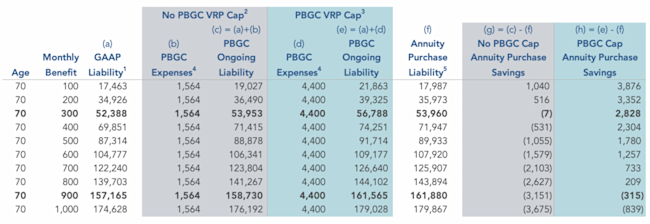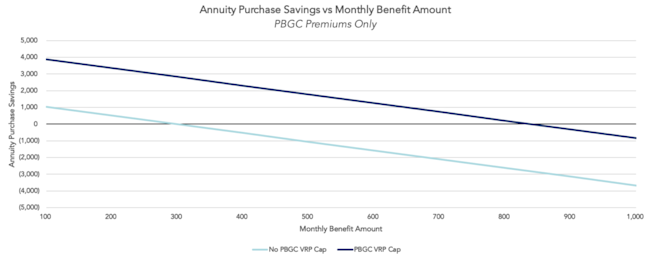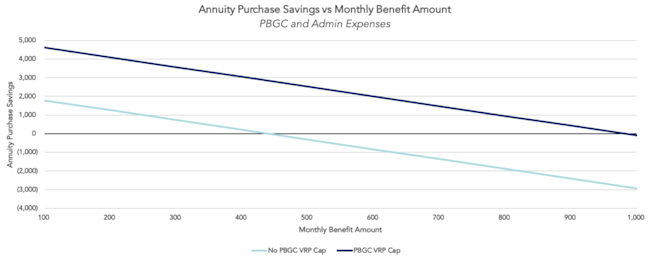Annuity Purchases for Small-Benefit Retirees – Guaranteed Savings
Overhead costs have skyrocketed for sponsors of traditional defined benefit plans. The main component of the skyrocketing cost is the insurance premiums paid to the Pension Benefit Guarantee Corporation (PBGC). The PBGC premiums are a combination of a fixed per participant fee and a variable rate based on the amount unfunded but capped at a per participant maximum. These components have grown greater than 200% for the fixed and 500% for variable rate since 2012.
Executive Summary
Overhead costs have skyrocketed for sponsors of traditional defined benefit plans. The main component of the skyrocketing cost is the insurance premiums paid to the Pension Benefit Guarantee Corporation (PBGC). The PBGC premiums are a combination of a fixed per participant fee and a variable rate based on the amount unfunded but capped at a per participant maximum. These components have grown greater than 200% for the fixed and 500% for variable rate since 2012.
Most plan sponsors have reduced their head counts in recent years to effectively manage these overhead costs. The first wave focused on lump sum windows for terminated vesteds, but in the past five years, hundreds of sponsors have purchased annuities for retirees, particularly those retirees with small monthly benefit amounts. In fact, plan sponsors have purchased more than $100 billion in annuities over the last 5 years and annuity purchases for 2020 are on track for an additional $25 billion.
Doing the Math
Many plan sponsors perceive annuity purchases as too expensive. Generally, plan sponsors arrive at this conclusion when comparing their GAAP (accounting) liability to the cost of an annuity purchase, where the annuity purchase price is typically a couple percent higher. This comparison ignores overhead costs (mostly PBGC premiums), as PBGC premiums and other overhead are not generally reflected in GAAP liabilities. When the present value of future PBGC premiums are added to GAAP liabilities, we have found that the annuity purchase price tends to be the lower number and the annuity purchase would result in improved corporate financial statements. This is especially true for retirees with small benefit amounts, as PBGC premiums do not vary with the size of a participants benefit.
With this concept in mind we set out to identify a “break-even” point, which is the monthly benefit amount for a given retired participant whereby the annuity purchase price is equivalent to GAAP liabilities with PBGC premiums included. For retirees with benefit amounts below the break-even point, the annuity purchase will be cheaper than retaining participants in the plan and continuing to pay PBGC premiums. For retirees with benefit amounts above the break-even point, the annuity purchase may be more expensive than retaining participants in the plan. Below are the results of our analysis on a hypothetical age 70 retiree with varying monthly benefit amounts. Our results were very similar for retirees at different ages.
We also conducted our analysis on two hypothetical plans, one which is subject to the PBGC Variable-Rate Premium Cap, and one which is not. The break-even points for both hypothetical plans are shown in bold below. You will see that the break-even point for plans not subject to the PBGC VRP Cap is approximately $300 and for plans subject to the cap the break-even point is approximately $900. If a given plan is paying PBGC variable-rate premiums but is not subject to the VRP Cap, the break-even point for the plan would likely fall between the $300 and $900 levels of our two hypothetical plans.

Additionally, in the table the only administrative cost component we assessed was PBGC premiums. When determining the break-even point for a specific plan, other administrative costs (e.g. the cost of processing monthly checks) could be incorporated in our analysis and this would drive break-even points even higher, identifying additional savings sponsors could attain from an annuity purchase. The impact of incorporating other administrative costs can be seen when comparing the two-line graphs below, one of which considers PBGC premiums only and the other includes a $50 per person per year administrative expense.


GAAP Liability calculated using Pri-2012 Mortality table with MP-2019 improvement scale as well as the October Three’s GAAP corporate bond yield curve as of 8/31/2020.
For this analysis we assume the plan is never subject to the PBGC Variable Rate Premium (VRP) Cap.
For this analysis we assume the plan will be subject to the PBGC VRP Cap for the next 5 years.
For plans not at the PBGC VRP Cap, this is the present value of all future PBGC Flat-Rate Premiums. For plans subject to the PBGC VRP Cap, this also includes the present value of PBGC Variable-Rate (capped) Premiums over the next 5 years.
The Annuity Purchase Liability assumes the annuity purchase price is 3% larger than GAAP. This is consistent with October Three’s historical findings for retirees. See here for additional details.
